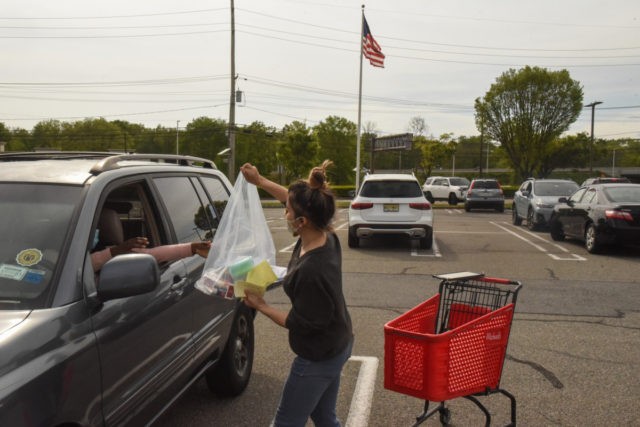NEW YORK (AP) — Late last year, Best Buy began testing curbside pickup at select stores as a way to respond to customer needs.
But that was then.
The pandemic accelerated the company’s plans and what was supposed to take months instead took just 48 hours, with Best Buy rolling out curbside pickup at nearly all of its 1,000 locations in late March as customers sought to minimize contagion by ordering online and pulling up to stores to collect their purchases.
That made all the difference, enabling Best Buy to retain 81 percent of last year’s sales in the first quarter even with its stores closed to shoppers, according to the company’s earnings release Thursday.
“There are scenarios we plan for as business leaders, and then there are events that simply do not have a playbook,” Best Buy CEO Corie Barry told analysts Thursday. “This is one of those times.”
It’s the latest example of how big box stores like Best Buy as well as Target, Walmart and others were able to capitalize on their digital expertise and stay relevant during the pandemic. As a result, they thrived during the fiscal first quarter.
Meanwhile, Macy’s and other mall-based clothing chains like Victoria’s Secret struggled to adapt. Macy’s sales were down 45 percent and the company says it could have a loss of at least $1 billion in the quarter. In contrast to Best Buy, it took Macy’s nine weeks starting in late March to introduce curbside pickup at 300 stores, or about 40 percent of all of its stores.
To be sure, Macy’s sells clothing and other merchandise that shoppers aren’t necessarily clamoring for in the middle of a pandemic while Best Buy offers items like computers and other electronics that suddenly became indispensable as more people began working from home. Macy’s was also quicker to offer curbside pickup compared with its department store peers.
Still, it shows how the pandemic is deepening the divide between big box stores and mall-based clothing chains. UBS predicts 100,000 store closings by 2025. Already, J. Crew, Neiman Marcus, Stages Stores and J.C. Penney have filed for Chapter 11 bankruptcy protection in the last month. Victoria’s Secret said that it will be closing 250 stores — about a quarter of its fleet — in the next few months.
“The divide was already widening between the big box operators and mall-based retailers,” said Ken Perkins, president of Retail Metrics. “The pandemic is now pushing it to the brink.”
Perkins said big box retailers have it in their “DNA to adjust quickly and were very early to adapt online early on their business.”
“Department stores conversely have been very slow to change,” he said. “Their business model has deteriorated.”
Perkins said that so far non-mall based stores are on track to post first-quarter earnings drop of 20.5 percent. That compares to mall-based chains, which are seeing earnings down more than three-fold, according to his roster of 103 retailers.
Walmart and Target, both of which were considered essential and were allowed to stay open because they carried items like toilet paper and groceries, reported soaring online sales and strong store sales while using their stores as distribution hubs.
Target’s CEO Brian Cornell said its stores were directly involved in supplying goods for 80 percent of online sales. Same-day services such as curbside pickup nearly tripled. Walmart, meanwhile, used about 2,500 stores to ship online orders. Lowe’s CEO Marvin Ellison credited its recent move to revamp its outdated online site months ago to move quickly to curbside pickup at its stores.
Analysts are closely watching shoppers’ behavior and their willingness to go back to the stores that are reopening.
TJX Cos., which operates T.J. Maxx and HomeGoods and Marshalls and is usually one of the retail darlings, took a beating because it was forced to temporarily close its stores and its fledgling online business. But the company sees “strong initial” sales from the stores that have reopened, and analysts believe the chain will bounce back. Its online site is now live.
Kohl’s said this week that sales had slumped more than 40 percent and it lost money in its first quarter. But its CEO Michelle Gass believes the chain will fare better than its peers since most of its stores are at strip centers. So far, it’s reopened about 50 percent of its 1,100 stores across the country.
Macy’s CEO Jeff Gennette said sales at the stores that have reopened have been “moderately higher than anticipated.” Earlier this month, he expected the reopened stores would generate less than 20 percent of their typical activity in the beginning stages.
Macy’s has acknowledged that it will emerge from the pandemic a smaller company. It began to reopen its stores early this month and about 190 Macy’s and Bloomingdale’s locations were operating in one form or another as of this week. It expects another 80 Macy’s stores to open for Memorial Day weekend and most of its stores, including its flagship stores in Manhattan, to open in mid-June.
Sales, the New York department store said in a preliminary report could plummet to around $3 billion from the $5.5 billion in sales booked just a year ago. It said it would likely swing to a quarterly loss of between $905,000 and $1.1 billion. It reported a steady uptick in its online business in April, but only partially offset the loss of store sales.
Macy’s had a profit of $203 million in last year’s first quarter, which ended on May 2.
The company will release more details about its quarterly performance early next month.
_______
Follow Anne D’Innocenzio: http://twitter.com/ADInnocenzio

COMMENTS
Please let us know if you're having issues with commenting.